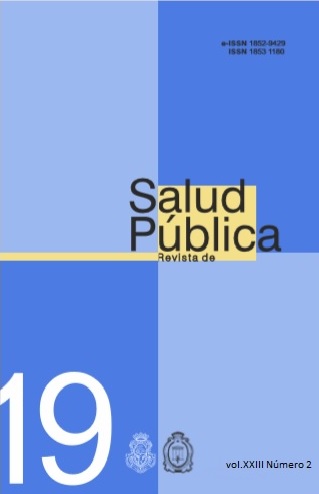Experience account: xylography as a Resource to learn about Scorpionism in children at primary school, in The city of Cordoba, Argentina
DOI:
https://doi.org/10.31052/1853.1180.v23.n2.24895Keywords:
educational experience, scorpion, neuroscience, xylography, science in artAbstract
Introduction: Although accidents with scorpions date from ancient times, they started to be registered as required by a new law fostered by the National Ministry of Health1 at the beginning of the year 2000. In the city of Cordoba, scorpionism has an important impact on public health, and every year there are numerous accidents due to stings2, 3, 4.Scorpions with medical relevance in Argentina belong to the type Tityus and T. trivittatusis the most frequent spices in Argentina1 . Tucuman and Cordoba are the provinces where the greatest number of cases have been reported2 . Between 2000 and 2011, there were 69,156 cases of accidents by scorpions in the country. Morbidity rate every 100,000 inhabitants was 2.7 and lethality was 0.05% with 31 deaths1 . Objectives: To inform students and teachers at two schools on the outskirts of the city about the problems of scorpionism and provide the necessary intellectual tools to recognize the insect, develop preventive actions and appropriate behavior in case of accident. Material and Methods: Contents were presented and interchanged in workshops where university tutors, school teachers and students participated; 354 students were involved. The study program presented the topic of scorpionism, together with health promotion tools, preventive measures and eradication techniques. Supported by recent contributions from neurosciences in order to foster learning and arouse the children’s interest, attention and emotion - key elements to achieve long lasting learning-8 , xylography, a creative technique, was associated to represent scorpions on wood engraving. Evaluation: High commitment of teachers and great disposition of the children were observed throughout the whole process, being able to represent the morphologic characteristics of scorpions as the corollary of the educational path, showing satisfaction when performing the creative work; as can be seen in the body expressions in the photographic documents (Photos 1,2,3,4). The experience finished with the exhibition of xylography images at Pabellón Argentina and PabellónBrujas, School of Visual Arts, National University of Cordoba. Conclusions: This experience shows that another type of learning is possible with the synergy between art and science; a new role of the University is seen, in the administration of knowledge towards the creation of conducts that can transform reality in valuable health practices. On the other hand, it implies an approach in which each participant of the educational process - professors, teachers and students - becomes an efficient vehicle to transmit health care information and an agent willing to change and transform reality.Downloads
References
1. De Roodt R et al. Accidentes y muertes por animales venenosos en Argentina durante el período 2000-2011. Revista Científica INSPILIP. Guayaquil, Ecuador V. 2017; (1) Número 1: 1-10.
2. Ministerio de Salud de la Nación. Boletín Integrado de Vigilancia Nº 344 -SE 03, [Internet] 2017; 56. Disponible en: http://www.msal.gob.ar/images/stories/boletines/Boletin-Integrado-De-Vigilancia-N344-SE3.pdf
3. Pizzi H, Sánchez R, Huck G. Artrópodos, su impacto en la salud. Ed. Rotagraf S.A; 2005.
4. Pizzi H, Sanchez R, Huck G. Tomas A. Artrópodos. Calentamiento global-nuevos desafíos-control de plagas. Ed. Premat. 2016; 63-69.
5. Diario La Voz. Córdoba: murió un niño picado por un alacrán. [Internet], Actualizado 25/09/2018. Disponible en: https://www.lavoz.com.ar/ciudadanos/ cordoba-murio-un-nino-picado-por-un-alacran
6. Diario La Voz. Córdoba Acompañaba a su hija internada, y la picó un alacrán en el Hospital de Niños , [Internet] Actualizado 27/12/2018. Disponible en: https://www.lavoz.com.ar/ciudadanos/acompanaba-su-hija-internada-y-pico-un-alacranen-hospital-de-ninos
7. Salomón O. Actualización en artrópodos de interés sanitario II. Ed. Ministerio de Salud de la Nación. 2010.
8. Mora, F. Neuroeducación: sólo se puede aprender aquello que se ama. Madrid. Alianza Editorial. 2013; 64-70; 72-79.
9. Ballarin F. Por qué recordamos lo que recordamos y olvidamos lo que olvidamos. Ed. Sudamericana; 2015.
10. Campanario JM; Moya A. ¿Cómo enseñar ciencias? Principales tendencias y propuestas». Revista Enseñanza de las Ciencias.1999;17:179-92.
11. Edwards V. La relación de los sujetos con el conocimiento. Revista Colombiana de
Educación.1993;27:28-35.
12. Davidson R, Begley S. El perfil emocional de tu cerebro. Destino; 2012.
13. IvinsJr WM. Imagen impresa y conocimiento. Editorial Gustavo Gilli, S.A. Barcelona; 1987.
14. McLuhan M. «La galaxia Gutenberg». Círculo de Lectores. Barcelona; 1998.
15. Moro JM. Un ensayo sobre grabado (A finales del siglo XX). Ed.Creática;1998.
16. Moro JM. La ilustración como categoría. Ed. Trea S.L.2004:122-4.
17. Muñoz, MT.Implicancias de la metacognición en el proceso educativo. Revista Psicología Cientifica.com, 2006; 8(7). Disponible en: http://www.psicologiacientifica.com/metacognicion-proceso-educativo.
18. Santillana Schön, D. La formación de profesionales reflexivos. Hacia un nuevo diseño de la enseñanza y aprendizaje en las profesiones. Madrid. Paidós. 1992.
19. Sáez, Cristina. Educar con cerebro. Rev. Quo México [Internet]. 2014 [citado 9 de Octubre 2018] 74-79. Disponible en: https://cristinasaez.wordpress.com/2014/10/06/neuroeducacion-o-como-educar-con-cerebro/
Downloads
Published
Issue
Section
License
Copyright (c) 2019 Escuela de Salud Pública y Ambiente. Facultad de Ciencias Médicas. Universidad Nacional de Córdoba

This work is licensed under a Creative Commons Attribution-NonCommercial 4.0 International License.
Authors who publish with this journal agree to the following terms:
- Authors retain copyright and grant the journal right of first publication with the work simultaneously licensed under a Creative Commons Attribution License which allows the work to be copied, distributed, exhibited and interpreted as long as it is not done for commercial purposes.
- Authors are able to enter into separate, additional contractual arrangements for the non-exclusive distribution of the journal's published version of the work (e.g., post it to an institutional repository or publish it in a book), with an acknowledgement of its initial publication in this journal.
- Authors are permitted and encouraged to post their work online (e.g., in institutional repositories or on their website) after the publication process. (See The Effect of Open Access). (See The Effect of Open Access).







